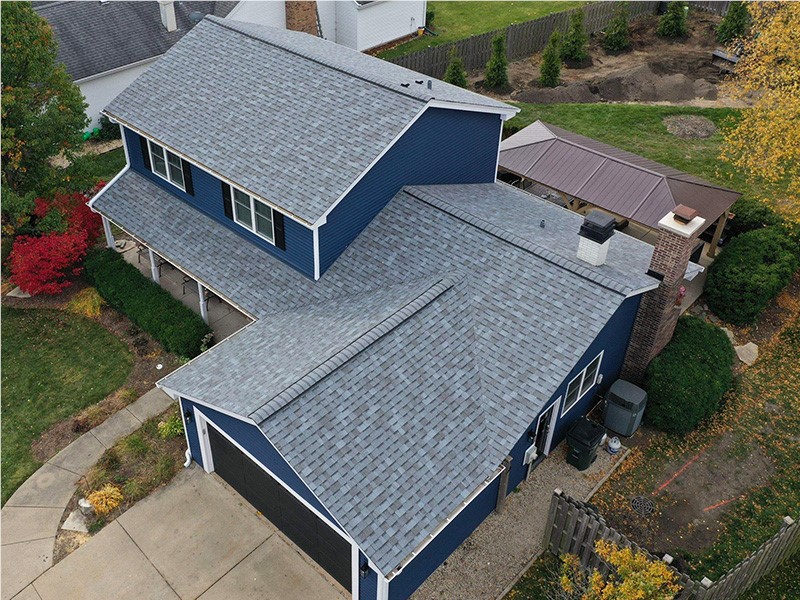
The roof is one of the most critical parts of a home, providing protection from the elements and keeping the house's interior dry and comfortable. However, choosing the right type of roof for your home can take time and effort, as many options are available on the market. Each type of roofing material has unique benefits and drawbacks, and the best choice for your home will depend on your specific needs, your home and budget. This article will explore some of the most popular roofing options and help you determine the best roof for your home.
Asphalt roof
Asphalt roofing is one of the most popular and widely used roofing materials in the United States. It is a type of shingle roofing made from a mixture of asphalt and crushed stone, and it is designed to be durable, low-maintenance, and cost-effective.
One of the significant advantages of asphalt roofing is its cost-effectiveness. Asphalt shingles are relatively inexpensive compared to other roofing materials, making them a popular choice for many homeowners due to its ease of installation plus it’s budget friendly options.
Another advantage of asphalt shingles is their durability. Asphalt shingles are designed to be weather-resistant and can stand up well to heavy rain, snow, and high winds. They also have a good fire resistance rating, which can be an essential consideration for some homeowners.
Asphalt shingles also come in a wide range of colors and styles, making them a versatile option for many different types of homes. They can match many different architectural styles, and the homeowner can choose the color best fits the house.
While there are many advantages to using asphalt shingles for your roof, there are also some potential drawbacks. One of the main downsides of asphalt shingles is that they have a shorter lifespan than some other roofing materials, usually between 15 to 20 years.
Metal roof
Metal roofing is a type of roofing that is made from metal sheets or tiles. It's becoming more and more popular among homeowners as it is known for its durability, longevity, and energy efficiency. Several types of metal roofing are available, such as aluminum, steel, copper, and zinc. Each of them has its own set of pros and cons.
One of the main advantages of metal roofing is its longevity. Metal roofs can last 50 years or more, making them one of the longest-lasting roofing options. In addition, they are resistant to wind, fire, and hail, making them suitable for areas with severe weather conditions.
Another advantage of metal roofing is its energy efficiency. Metal roofs reflect the sun's rays, reducing heat absorption and helping to keep your home cooler in the summer; this can help to lower your cooling costs and improve the overall energy efficiency of your home.
Metal roofing is also a low-maintenance option and is resistant to rot, mold, and insects. Additionally, it is available in various colors and styles, making it a versatile choice that can match any architectural style.
However, there are also some downsides to consider regarding metal roofing. One of the main disadvantages is the cost. Metal roofs can be more expensive than other roofing materials, such as asphalt shingles, and the installation process can be more complex and time-consuming.
Another potential drawback of metal roofing is that it can be noisy during heavy rain or hail. Metal roofs can also dent if hit by large hail or debris. Additionally, metal roofs can become slippery when wet, which can concern some homeowners.
Slate roof
Slate roofing is a type of roofing that is made from natural slate rock. It is known for its beauty, durability, and longevity. Slate roofs are often found in historic and high-end homes, but they are also becoming popular in modern homes.
One of the main advantages of slate roofing is its longevity. Slate roofs can last for over 100 years with proper maintenance. In addition, they are incredibly durable and can withstand severe weather conditions such as heavy rain, snow, and high winds. They are also fire resistant, making them a suitable choice for areas with an increased risk of wildfire.
Another advantage of slate roofing is its aesthetic appeal. Slate roofs have a unique, natural beauty that can add to the curb appeal of any home. They are also available in various colors, including black, gray, green, and purple. They can match any architectural style and be cut in different shapes and sizes.
Slate roofing is also environmentally friendly. It is a natural and renewable resource and is recyclable. Additionally, it does not contain any harmful chemicals or pollutants.
However, there are also some downsides regarding slate roofing. One of the main disadvantages is the cost. Slate roofs can be costly in terms of materials and installation. They are also heavy, meaning the house's structure needs to be reinforced before installation; this can add to the cost.
Wood roof
Wood roofing is a type of roofing that is made from wood shingles or shakes. It is known for its natural beauty, warmth, and durability. Wood roofing can add a rustic, natural charm to any home, and it is becoming increasingly popular among homeowners looking for a unique and eco-friendly roofing option.
One of the main advantages of wood roofing is its natural beauty. Wood roofs have a unique, natural beauty that can add to the curb appeal of any home. They are available in various colors and finishes and can match any architectural style. Additionally, wood's natural insulation properties can help keep your home warmer in the winter and cooler in the summer.
Another advantage of wood roofing is its environmental friendliness. Wood is a renewable and sustainable resource, biodegradable and recyclable; this can be an essential consideration for homeowners looking for an eco-friendly roofing option.
Wood roofing is also relatively easy to install and repair. It is not as brittle as other roofing materials and is relatively lightweight, making the installation more accessible and less time-consuming.
However, there are also some downsides to consider regarding wood roofing. One of the main disadvantages is its lifespan. Wood roofs can last approximately 15 to 30 years, but regular maintenance and treatments can help it last longer. They also require regular maintenance and treatments to prevent rot, decay, and insect infestations.
Another potential drawback of untreated wood roofing is that it can be readily ignited by firebrands, sparks and direct exposure to fire. Untreated wood roofs are highly flammable and require a fire-retardant treatment to protect against fire. They also need to be treated with chemicals to protect them from rot, decay, and insects, which can concern some homeowners. They require regular ongoing maintenance.
Synthetic composite roof
Synthetic composite roofing is a durable, low-maintenance, versatile homeowner roofing option. It comes in a wide range of styles and colors and can mimic the look of natural materials such as wood, slate, and tile. However, it can be more expensive than traditional roofing materials and is made of recycled materials such as rubber and plastic. Plus, synthetic composite roofs are newer in the roofing industry compared to others on the market.
Solar panels on roof
Solar panel roofs offer a cost-effective and environmentally friendly option for homeowners. They require low maintenance and have a long lifespan. Contact us about the cost of installation, since this varies from roof to roof and to discuss placement to ensure maximum efficiency on the amount of sunlight received. Learn more here: www.prohome1.com/roofing/solar-panels/
How to know which roof is best for your home?
When it comes to choosing the right roof for your home, there are a lot of factors to consider. The type of roofing material, the cost, the weather conditions in your area, and the architectural style of your home are all important considerations. Here are some tips to help you determine the best roof for your home.
- Consider the weather conditions in your area: Some roofing materials are better suited for specific weather conditions than others. For example, if you live in an area with heavy snowfall or high winds, you'll want to choose a roofing material to withstand those conditions.
- Think about the architectural style of your home: The type of your home should also be considered when choosing a roofing material. For example, some materials, like slate, are better suited for traditional or historic homes, while others, like metal, can be used in contemporary or modern homes.
- Consider the cost: One of the most important factors when choosing a roofing material is cost. Some materials, like slate or tile, can be more expensive than others, like asphalt shingles. Therefore, selecting a material that fits your budget is essential.
- Research the different types of roofing materials: There are many kinds available, each with its pros and cons. Researching the various options and weighing the pros and cons to determine which material is best for your home is essential.
- Consult a professional: We’re a professional roofing contractor and can help you determine the best roofing material for your home. We take into consider our Midwest climate, the seasonal weather conditions, the architectural style of your home, and your budget to recommend the best option for your specific situation and home.
Ultimately, the best roof for your home will depend on your specific needs, budget, and area conditions. We hope this article has helped in answering your questions. If you’re ready to make the next step, contact us today and we can help you make an informed decision to ensure your home remains safe and comfortable for many years.
Tags
Subscribe to Pro Home 1's Blog








Comments